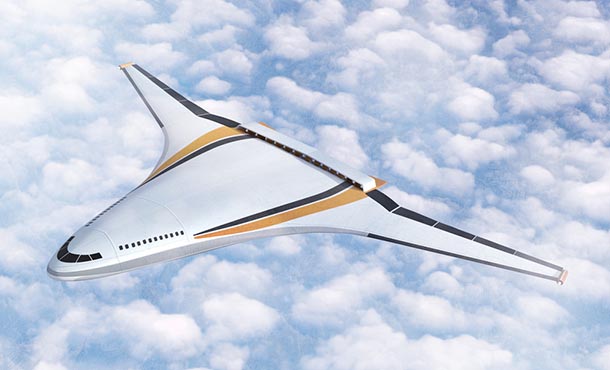
N3-X Hybrid Wing Body Turboelectric Plane Concept. IMAGE: NASA
$8 million NASA grant pilots course to hybrid-powered aircraft
Female-led team in the Penn State Department of Mechanical Engineering seeks to reimagine gas turbine engines within hybrid electric propulsion systems to decrease the carbon footprint of aviation
1/29/2021
By Erin Cassidy Hendrick
UNIVERSITY PARK, Pa. — Leading a diverse, collaborative coalition that spans universities, industry and disciplines, Penn State has been awarded $8 million from the National Aeronautics and Space Administration (NASA) to chart the course for hybrid electric aircraft.
“This is a bold project that will explore the possibility of a safe, efficient and innovative path to reduce the fuel consumption and lower the carbon footprint of the aviation industry,” said Karen Thole, distinguished professor, mechanical engineering department head and the principal investigator.
The four-year project will focus on single and twin-aisle aircraft that carry 100 passengers or more, which the researchers say are well suited for hybrid propulsion.
However, it is not as simple as integrating a battery into a traditional, gas-powered propulsion system, according to Thole. The team will seek to reimagine the entire system, optimizing and re-designing the core of the gas turbine engine.
“With our collaborators, we will use all the knowledge surrounding these hybrid systems and find new ways to operate them with increased efficiency,” said Reid Berdanier, assistant research professor in mechanical engineering.
According to the researchers, Penn State, with its historic strengths in gas turbines, is pioneering the development and testing of concepts for small engine cores that are efficient and integrate well into the hybrid system. They will be using emerging technologies such as additive manufacturing, machine learning and cyber-physical modeling to forge these new frontiers in hybrid propulsion.
“The goal is to shrink the engine as much as possible,” Thole said. “In doing so, this brings up other technical issues, including how to manufacture the parts and how to improve efficiencies.”
Amrita Basak, assistant professor of mechanical engineering, explained using metal additive manufacturing (AM), commonly referred to as metal 3D printing, will be an enabling technology to reduce the size of the engine core.
“This could push the boundary of AM,” she said. “Optimizing part precision, surface roughness and conformity on such a small scale could change the way we 3D print metallic parts.”
Thole explained that by leveraging the National Experimental Turbine (NExT) program in the Steady Thermal Aero Research Turbine (START) Laboratory, the AM capabilities at the Center for Innovative Materials Processing Through Direct Digital Deposition (CIMP-3D) and the resources of the Materials Research Institute, Penn State is uniquely positioned to lead this project.
She also noted the guidance offered by the University’s Strategic Interdisciplinary Research Office in the Office of the Senior Vice President for Research significantly contributed to the proposal’s success.
“The broad coalition of partners dedicated to the hybrid electric airplane project has enormous potential to develop advances and engage in innovation and discovery to bring transformational change to the field,” said Lora Weiss, senior vice president for research. “We were pleased to support the development of their proposal and the assembly of the strong interdisciplinary research team and are excited that it will result in foundational knowledge for NASA and society at large.”
Other key facets will include integrating machine learning and cyber-physical models, spearheaded by Michaela Amoo and Ahmed Rubaai from Howard University, and systems level architecture, led by Georgia Tech’s Timothy Lieuwen and Brian German.
NASA’s funding was provided by the agency’s University Leadership Initiative, which was created to empower universities to collaborate to pioneer technologies with significant impacts on aeronautics and aviation. This project represents the first female-led team funded by the initiative.
“This is a proud moment for us,” Thole said. “I’m honored to be a part of such a talented and diverse team. These unique minds and experiences are absolutely going to strengthen the project. Our team is also committed to educating a diverse group of students who will impact the future of aviation through unique research opportunities.”
In addition to solidifying collaborations between the universities, the project will draw upon valuable insights from their industry partners: Pratt & Whitney, a world leader in designing and manufacturing aircraft and helicopter engines and auxiliary power units, and CVD MesoScribe will use a novel approach to deposit sensors on the additively manufactured gas turbine components.
“With the aviation market estimated to grow at around 4.5%, our industry’s contribution to global CO2 will need to decrease so the aerospace industry’s commitment to sustainability has never been stronger,” said Sean Bradshaw, technical fellow in sustainable propulsion at Pratt & Whitney. “A strong research collaboration between academia and industry is vital and the fundamental insights generated from this important research will augment current efforts by the aviation industry to become more sustainable.”
Additional collaborators include Irewole Orisamolu, Pratt & Whitney, Jeffrey Brogan, CVD MesoScribe and Collins Aerospace.



